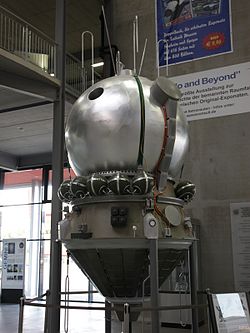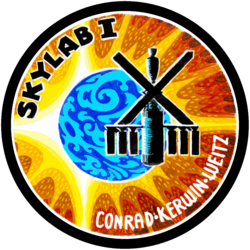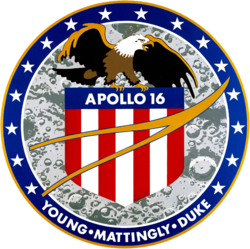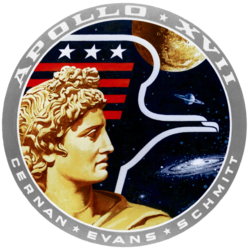Apollo 17
| Apollo 17 | |||
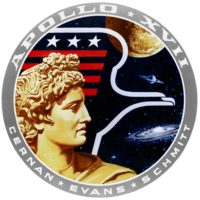 | |||
| Statistik för uppdraget | |||
|---|---|---|---|
| Uppdrag | Apollo 17 | ||
| NSSDC-ID | Kommandomodul: 1972-096A[1] Månlandare: 1972-096C[2] | ||
| Kommandomodul | America | ||
| Månlandare | Challenger | ||
| Anrop | America Kommandomodul Challenger Månlandare | ||
| Uppskjutning | |||
| Raket | Saturn V | ||
| Uppskjutningsramp | John F. Kennedy Space Center LC-39 A | ||
| Uppskjutning | 7 december 1972, 05:33:00 UTC | ||
| Landning | |||
| Landning | 19 december 1972, 19:24:59 UTC | ||
| Månen | |||
| Antal varv kring månen | 75 st | ||
| Månlandning | 11 december 1972, 19:54:57 UTC | ||
| Månuppskjutning | 14 december 1972, 22:54:37 UTC | ||
| Antal månpromenader | 3 st | ||
| Månpromenader, längd | 22 timmar, 3 minuter, 57 sekunder | ||
| Dockning | |||
| Dockning | 7 december 1972, 09:30:10 UTC | ||
| Ur dockning | 11 december 1972, 17:20:56 UTC | ||
| Andra dockningen | 15 december 1972, 01:10:15 UTC | ||
| Andra ur dockning | 15 december 1972, 04:51:31 UTC | ||
| Rymdpromenad | |||
| Antal rymdpromenader | 1 st | ||
| Total tid för rymdpromenad | 1 timme, 5 minuter, 44 sekunder | ||
| Besättning | |||
| Befälhavare | Eugene Cernan | ||
| Pilot | Ronald E. Evans (kommandomodulen) Harrison Schmitt (månlandaren) | ||
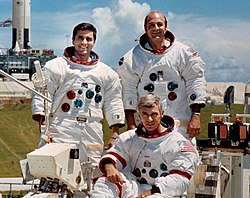 | |||
| Kronologi | |||
| |||
Apollo 17 var i december 1972 den elfte bemannade uppskjutningen i Nasas Apolloprogram, och var den sjätte och sista månlandningen i programmet. Den var även Nasas första nattuppskjutning.
Apollo 17 landade öster om Mons Argaeus i Taurus-Littrow-dalen[3], intill Mons Vitruvius och söder om kratern Littrow.
Apollo 17 hade, liksom Apollo 15 och Apollo 16, med sig en eldriven månbil så att astronauterna kunde göra milslånga expeditioner på månen. Sammanlagt färdades astronauterna 35 kilometer under 22 timmar med den medhavda månbilen.[3]
På väg till månen tog besättningen det berömda fotot "Den blå pärlan".
- Eugene A. Cernan under Apollo 17
- "I was strolling on the Moon one day" video
Besättning
- Eugene Cernan, befälhavare.[3] Cernan är fortfarande den som senast satt sin fot på månytan.[4]
- Ronald E. Evans[4], pilot för kommandomodulen
- Harrison Schmitt[4], pilot för månlandaren
Reservbesättning
- John W. Young, befälhavare
- Stuart Roosa, pilot för kommandomodulen
- Charles Duke, pilot för månlandaren
Väckningar
Under Geminiprogrammet började NASA spela musik för besättningar och sedan Apollo 15 har man varje "morgon" väckt besättningen med ett musikstycke, särskilt utvalt antingen för en enskild astronaut eller för de förhållanden som råder.
Referenser
- ^ ”NASA Space Science Data Coordinated Archive” (på engelska). NASA. https://nssdc.gsfc.nasa.gov/nmc/spacecraft/display.action?id=1972-096A. Läst 27 mars 2020.
- ^ ”NASA Space Science Data Coordinated Archive” (på engelska). NASA. https://nssdc.gsfc.nasa.gov/nmc/spacecraft/display.action?id=1972-096C. Läst 27 mars 2020.
- ^ [a b c] ”Apolloprojektet - Uppslagsverk - NE.se”. www.ne.se. https://www.ne.se/uppslagsverk/encyklopedi/l%C3%A5ng/apolloprojektet. Läst 8 juli 2022.
- ^ [a b c] ”Eugene Cernan | Biography, Space Flights, & Facts | Britannica” (på engelska). www.britannica.com. https://www.britannica.com/biography/Eugene-Andrew-Cernan. Läst 8 juli 2022.
Externa länkar
 Wikimedia Commons har media som rör Apollo 17.
Wikimedia Commons har media som rör Apollo 17.
| |||||||||||||||||||||||||||||||||||||||||||
| ||||||||||||||||||||||||||||||||
Media som används på denna webbplats
Författare/Upphovsman: Pascal (Flickr user: pasukaru76), Licens: CC0
Vostok spacecraft replica at the Technik Museum Speyer, Germany.
Apollo 17 mission, 12 December 1972.
Astronaut Eugene A. Cernan, commander, makes a short checkout of the Lunar Roving Vehicle (LRV) during the early part of the first Apollo 17 Extravehicular Activity (EVA-1) at the Taurus-Littrow landing site. This view of the "stripped down" LRV is prior to loading up. Equipment later loaded onto the LRV included the ground-controlled television assembly, the lunar communications relay unit, hi-gain antenna, low-gain antenna, aft tool pallet, lunar tools and scientific gear. This photograph was taken by scientist-astronaut Harrison H. Schmitt, lunar module pilot. The mountain in the right background is the east end of South Massif. While astronauts Cernan and Schmitt descended in the Lunar Module (LM) "Challenger" to explore the Moon, astronaut Ronald E. Evans, command module pilot, remained with the Command and Service Modules (CSM) "America" in lunar-orbit.
"The Blue Marble" is a famous photograph of the Earth taken on December 7, 1972, by the crew of the Apollo 17 spacecraft en route to the Moon at a distance of about 29,400 kilometres (18,300 mi). It shows Africa, Antarctica, and the Arabian Peninsula.
"I was strolling on the Moon one day" video - Apollo 17. More than half of the footage (0:07 to 0:24) is actually from Apollo 16 (Duke and Young approaching House Rock at North Ray crater).
The prime crew for the Apollo 17 lunar landing mission are: Commander, Eugene A. Cernan (seated), Command Module pilot Ronald E. Evans (standing on right), and Lunar Module pilot, Harrison H. Schmitt. They are photographed with a Lunar Roving Vehicle (LRV) trainer. Cernan and Schmitt will use an LRV during their exploration of the Taurus-Littrow landing site. The Apollo 17 Saturn V Moon rocket is in the background. This picture was taken at Pad A, Launch Complex 39, Kennedy Space Center (KSC), Florida.
This is the emblem for the first manned Skylab mission. It will be a mission of up to 28 days. Skylab is an experimental space station consisting of a 100-ton laboratory complex in which medical, scientific and technological experiments will be performed in Earth orbit. The prime crew of this mission will be astronaut Charles Conrad Jr., commander; scientist-astronaut Joseph P. Kerwin, science pilot; and astronaut Paul J. Weits, pilot. The patch, designed by artist Kelly Freas, shows the Skylab silhouetted against the Earth's globe, which in turn is eclipsing the sun--showing the brilliant signet-ring pattern of the instant before the total eclipse.
Apollo 16 mission logo
The Apollo 16 crew patch is dominated by an eagle perched atop a red, white and blue shield a superimposed on a lunar scene, surrounded by a blue circle of 16 stars with the crew's surnames completing the bottom are of the circle. Across the face of the shield is a gold symbol of flight outlined in blue, similar to that on the National Aeronautics and Space Administration (NASA) agency seal and insignia. The design was created by NASA artist Barbara A Matelski[1][2] from ideas submitted by the three crew members: astronauts John W. Young, commander; Thomas K. Mattingly II, command module pilot; and Charles M. Duke Jr., lunar module pilot.
This is the official emblem of the Apollo 17 lunar landing mission which was flown by astronauts Eugene A. Cernan, Ronald E. Evans and Harrison H. Schmitt.
- The insignia is dominated by the image of Apollo, the Greek sun god. Suspended in space behind the head of Apollo is an American eagle of contemporary design, the red bars of the eagle's wing represent the bars in the United States flag; the three white stars symbolize the three astronaut crewmen. The background is deep blue space and within it are the moon, the planet Saturn and a spiral galaxy or nebula. The moon is partially overlaid by the eagle's wing suggesting that this is a celestial body that man has visited and in that sense conquered. The thrust of the eagle and the gaze of Apollo to the right and toward Saturn and the galaxy is meant to imply that man's goals in space will someday include the planets and perhaps the stars. The colors of the emblem are red, white and blue, the colors of our flag; with the addition of gold, to symbolize the golden age of space flight that will begin with this Apollo 17 lunar landing. The Apollo image used in this emblem was the famous Apollo of Belvedere sculpture now in the Vatican Gallery in Rome. This emblem was designed by artist Robert T. McCall in collaboration with the astronauts.





